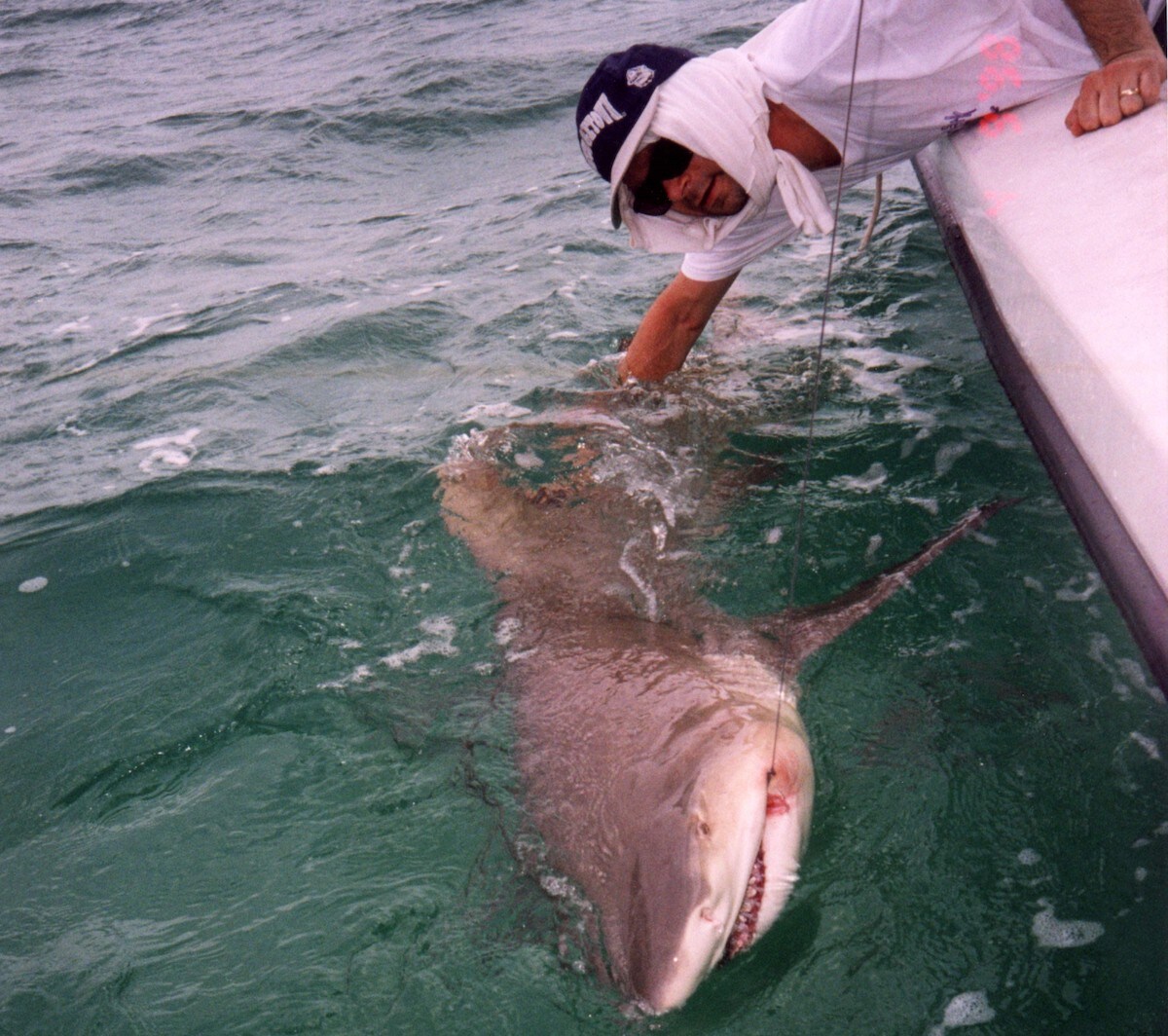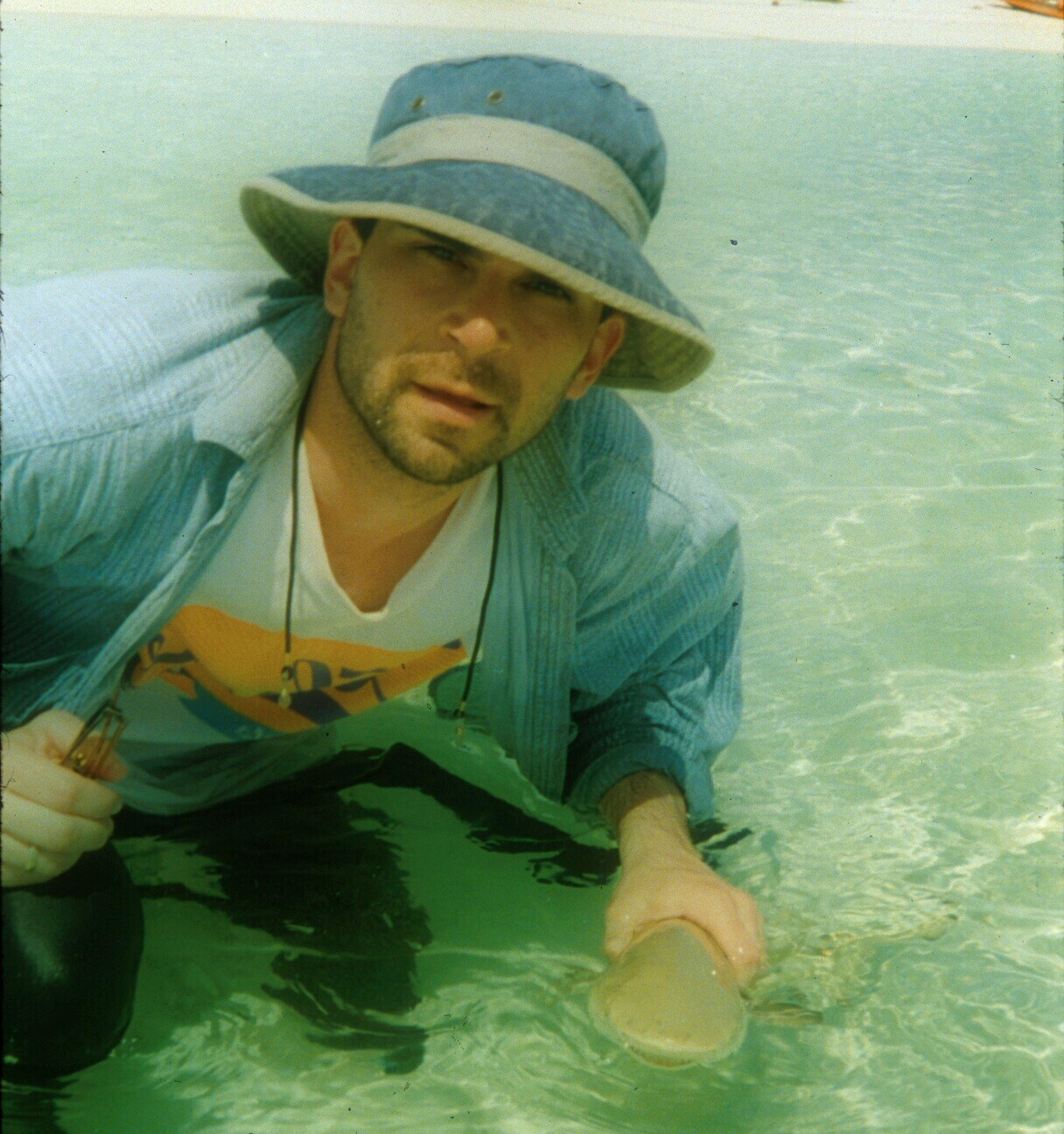Written by Caroline McMahon and Cleta D’Sa
When the movie Jaws hit the big screen in 1975, a big change happened to public and scientific perception of sharks as it portrayed them as vindictive creatures who go after individuals with an intent to kill. We all know now that “sharks don’t target human beings and they don’t hold grudges.”1 Kevin Feldheim, PhD, knows and appreciates this fact more than most. While he was too young to watch it when it debuted, Jaws and its societal effect on attitudes toward sharks, along with living near a beach in California, sparked an initial interest that would lead to a life-long passion and career dedicated to shark study and animal conservation.
Feldheim combined his interest in using DNA and genetics to research life histories of different animals and how to use that for conservation with his love of sharks when working on his PhD in Biology at the University of Illinois at Chicago. Since 2001, he has been the A. Watson III Manager of the Pritzker Laboratory for Molecular Systematics and Evolution at the Field Museum in Chicago, where he is responsible for making sure that the DNA lab runs smoothly, including equipment oversight. When not tending to the lab, he is also able to pursue his research: using DNA to understand different life history aspects of the elasmobranch (sharks, rays, and skates) and inferring the mating system and population biology of sharks.
Feldheim’s research goes back to 1995, when he started working on an existing project that was examining the population of lemon sharks at Bimini, Bahamas, where the surrounding seagrass and mangroves provide habitats for juveniles of many fish species. Once baby lemon sharks are born there, they don’t leave the safety of the mangroves for the first few years of their lives. Over the course of the first few years, up to 90% of sharks, which is anywhere from 100 to 200, can be caught, making Bimini one of the best populations to study.2 With lemon sharks being the most abundant elasmobranch found at Bimini, they play a vital role in the ecosystem as a top predator and serve as an indicator of the overall health of the environment.
The reliability of microsatellite analysis
To get a better understanding of how the lemon sharks use these mangroves, Feldheim has been continuing a large-scale, long-term population study that employs microsatellite analysis technology with capillary electrophoresis. Microsatellite markers are co-dominant, polymorphic DNA loci containing repeated nucleotide sequences, typically with 2 to 10 nucleotides per repeated unit. They are useful for population genetic studies because many are considered polymorphic. These different allele frequencies increase the potential to observe genetic differences between populations if they exist.
Because so many pups can be captured from a litter, the genotypes from the microsatellites of the babies can be used to reconstruct the parental generation. What makes this so incredible is that adult sharks do not have to be caught in order to get a genotypic reconstruction of them. The mating behavior of the adults can be inferred based on the genotypes of the young. By applying a capture and tag method, a small piece of fin tissue is clipped from every captured shark, and genomic DNA is extracted. Each fin is then genotyped using capillary electrophoresis at nine microsatellite loci developed from a lemon shark genomic library. With 9 loci and their degree of variation, these microsatellite markers provided high resolution for individual identification.
 What the research revealed for the first time is that female lemon sharks practice natal philopatry, meaning they return to their natal lagoon to give birth, much like salmon return to their native river to spawn. Pregnant females use Bimini, some do so exclusively, for parturition on a biennial cycle.3
What the research revealed for the first time is that female lemon sharks practice natal philopatry, meaning they return to their natal lagoon to give birth, much like salmon return to their native river to spawn. Pregnant females use Bimini, some do so exclusively, for parturition on a biennial cycle.3
To further understand the consistency of the technology, Feldheim explains, “When I first started, we were doing slab gels on the 373 genetic analyzer, and then we graduated to the 3100, and now we use the 3730xl, applying microsatellite analysis all along the way.” According to Feldheim, two microsatellite markers give 60% identification, nine or eleven gives accurate identification up to 99.99999999%.3 With the current set of microsatellites, a genetic fingerprint of every individual has been sampled so far, which is approaching approximately 5,000 individual sharks, contributing to what is the largest database in existence for any shark species.
The simplicity and precision of capillary electrophoresis using fragment analysis
Feldheim relies heavily on fragment analysis by capillary electrophoresis for his research and uses it almost on a daily basis, including for projects other than lemon sharks, stating, “It’s very good when we’re doing smaller projects like identifying fins. I still consider capillary electrophoresis to be cutting technology even though it has been a part of my career for 20 years. There is something very comforting about validating each electropherogram by eye, something that is simply impossible to do with NGS data.” He adds, “Microsatellite analysis by fragment analysis is a simple and robust tool for species identification and population studies. A key advantage of capillary electrophoresis over NGS for microsatellite analysis is that it is cost-effective for rapid sequencing for low number of targets. It has considerable impact due to its precision and simplicity.”
Long-term effect on conservation
Lemon sharks rely on the lagoon for every stage of their life history. Juveniles are intimately tied to mangroves for the first several years of life, using this habitat for protection from predation and as a feeding ground. Further degradation of the habitat will have both a local and regional effect as some may use the Bimini lagoon exclusively for mating.4 “If natal homing is happening elsewhere,” says Feldheim, “we really need to focus our conservation efforts locally at these individual nursery sites in order to properly conserve whole populations.”
When Feldheim isn’t busy running the DNA lab or swimming with the sharks for research, he redirects his passion and joy to watching his 16-year old twins play volleyball. But as far as letting his kids swim with the sharks? Well, even though it’s been over 40 years since Jaws changed our perception of the ocean, and even with the help of research being done by Feldheim and his team over the last 20 years helping to loosen its grip, Feldheim still hasn’t taken them swimming with the sharks, although he hopes to someday soon.
References
1. Peter Benchley, author, Jaws, quote, London Daily Express, 2006
2. Gruber SH, De Marignac JRC et al. (2001) Survival of Juvenile Lemon Sharks Bimini, Bahamas, Estimated by Mark – Depletion Experiments. Transactions of the America Fisheries Society 130, 376-384
3. Feldheim K, Gruber SH et al. (2005) Genetic tagging to determine passive integrated transponder tag loss in lemon sharks.) Journal of Fish Biology 61:1309-1313. doi:10.1006/jfbi.2002.2139
4. Feldheim K, Gruber SH et al. (2014) Two decades of genetic profiling yields first evidence of natal philopatry and long-term fidelity to parturition sites in sharks. Molecular Ecology 23, 110-117. Doi 10.1111/mec.12583
For Research Use Only. Not for use in diagnostic procedures.
Leave a Reply